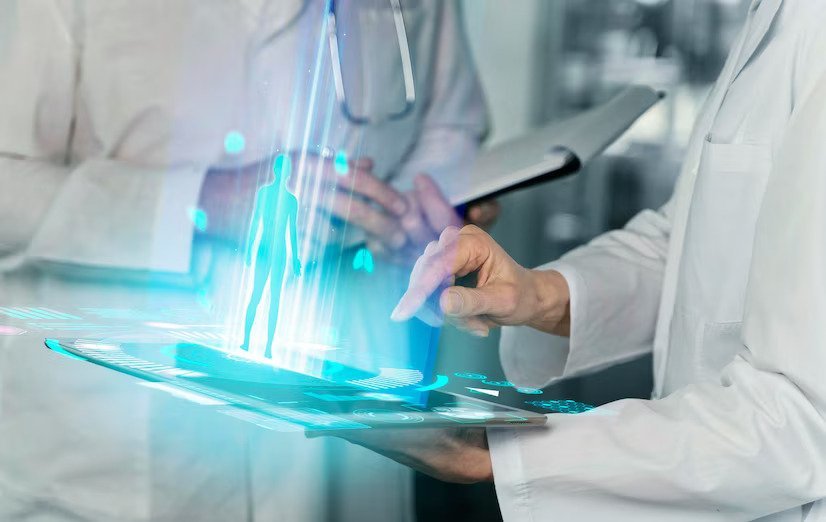
Healthcare is a career where nurses and other professionals offer a personal touch in communicating with patients and their families. They also help develop new, safer, and easier ways of providing treatment. Many of these developments happen because of advancements in technology. Here, we look at the uses that technology has in medicine and healthcare and how it might help future developments.
The Uses Of Technology In Medicine And Healthcare
The future of medicine is expected to be greatly impacted by advancements in technology, making healthcare more personalized, efficient, and effective. Some of the current uses of technology and the ideas that are already being developed or improved can show us where technology is heading in relation to healthcare. Some of these include:
- Precision medicine: Precision medicine refers to the use of genomic information, medical history, and lifestyle data to predict and prevent disease and provide more targeted treatments.
- Artificial intelligence and machine learning: Algorithms can be used to help analyze large amounts of patient data, highlight patterns, and make predictions about diseases and treatments.
- Telemedicine: This is expected to become increasingly common, making it possible for more patients to consult with doctors and specialists remotely, reducing the need for in-person visits.
- Gene editing and CRISPR technology: This technology could potentially cure genetic disorders and some types of cancer, in addition to preventing the transmission of genetic diseases so that they are eventually eliminated or become rarer.
- Nanomedicine: Nanotechnology in medicine, such as the development of nanorobots, can be programmed to target and treat specific cells and tissues.
- Wearables and sensors: These devices and sensors track vital signs and monitor health metrics and are expected to become more common in encouraging people to monitor their own health while only seeking medical attention when necessary.
- Regenerative medicine: This type of medicine is used to repair or replace damaged cells, tissues and organs by using stem cells, growth factors, and other biological materials.
These developments have the potential to transform the way we approach healthcare, providing more personalized and effective treatments and preventing or curing diseases in new and innovative ways. Now is a great time to pursue a career in nursing. If you’re reading this and thinking, “I have a bachelor’s degree, how do I become a nurse”, then click here for more information. Rockhurst University offers an accelerated BSN program to help you reduce the time it takes to graduate and qualify for a career in nursing.
Precision Medicine
Going back to the different uses technology has in healthcare, we’ll start by looking in more detail at precision medicine. This is an approach to healthcare that takes into account the individual characteristics of patients, such as their genetic makeup, lifestyle, and medical history, to predict and prevent disease and to provide more targeted treatments.
The goal of precision medicine is to move away from a “one-size-fits-all” approach to healthcare. Instead, it helps provide treatments that are tailored to the specific needs of your patients. This is achieved by using genomic information, medical records, and other data to develop a fuller understanding of each patient’s health and identify the best treatments and medications for them.
Precision medicine means effective treatment, reducing the risk of adverse drug reactions and improving patient outcomes. It is being used in a variety of medical fields, including oncology, cardiology, and neurology, and is expected to play a larger role in the future of medicine. It is still a relatively new field in medicine, and more research is needed to gain a better understanding of its potential benefits and limitations. There are privacy concerns and ethical implications of using genomic information and other personal data in medical decision-making. However, as with most technological improvements in nursing and other fields, constant updates and amendments take all of this into account and will improve over time.
Artificial Intelligence (AI) And Machine Learning (ML)
These technologies are being used in a variety of ways, including:
- Diagnosis and treatment planning: AI and ML analyze large amounts of medical data, including imaging and electronic health records, identifying patterns and making predictions about diagnoses and treatments. This process can improve the accuracy and speed of diagnoses and help healthcare providers make better-informed decisions about patient care.
- Predictive analytics: Artificial learning and machine learning can be used to analyze data from wearable devices and other sources to predict the onset of diseases and provide early warnings to healthcare providers. This contributes to improving patient outcomes and preventing the deterioration caused by chronic conditions.
- Drug development and personalized medicine: AI and ML analyze vast amounts of data to identify new drugs and develop personalized treatments based on the patient’s medical history and genetics.
- Clinical decision support: AI and ML are also used to support healthcare providers in making clinical decisions. This includes identifying patients who are at risk of developing certain conditions or providing recommendations for treatments based on the latest research.
- Healthcare administration: AI and ML can be used to improve the efficiency and quality of healthcare administration, such as by automating routine tasks, reducing medical errors, and improving patient flow through the healthcare system.
AI and ML in medical decision-making raise certain ethical questions. As with most advancements in technology, these are dealt with and improved on whenever new concerns are brought to attention.
Telemedicine
Telemedicine is the delivery of healthcare services and information through telecommunication technologies, such as video conferencing, phone calls, and remote monitoring devices. The goal of telemedicine is to give patients access to healthcare services regardless of their location while improving the efficiency and quality of the healthcare they receive.
Telemedicine has several benefits, including:
- Increased access to care: Telemedicine can provide patients with access to healthcare services in remote or underserved areas, where it is challenging to receive care in person.
- Improved convenience: Telemedicine allows patients to receive care from the comfort of their own homes without the need to travel to a healthcare provider’s office, which is helpful for those with physical limitations.
- Reduced costs: Costs associated with healthcare delivery, such as the cost of travel and missed work, can be reduced.
- Improved care coordination: Telemedicine can improve care coordination between healthcare providers by providing real-time access to patient information and making collaborations between care teams possible.
A variety of healthcare services can benefit from telemedicine, including consultations with specialists, remote monitoring of patients with chronic conditions, and the delivery of mental health services or psychiatric telemedicine.
Despite the challenges such as potentially unreliable internet connections, telemedicine has the potential to play a larger role in the future of healthcare, improving the lives of millions of people around the world.
CRISPR (Clustered Regularly Interspaced Short Palindromic Repeats)
CRISPR is a revolutionary new technology that allows scientists to edit DNA with unprecedented precision. The CRISPR system uses an enzyme called Cas9, guided by RNA, to cut DNA at specific locations, allowing scientists to make specific changes to the DNA sequence.
CRISPR technology has the potential to transform the field of medicine in several areas, including:
- Disease treatment: CRISPR can be used to treat genetic diseases by editing the DNA of cells in the body to correct mutations that cause disease. This may cure conditions such as sickle cell anemia and cystic fibrosis.
- Cancer therapy: CRISPR could improve the efficiency of cancer therapies by targeting cancer cells specifically and leaving normal cells unharmed.
- Agricultural and environmental applications: It can be used to enhance crop yields, improve food security and address environmental challenges by making genetic modifications to plants and animals. This in turn helps people eat a healthier diet, which has many health benefits.
- Basic research: CRISPR is also being used in basic research to study the function of genes and to develop a better understanding of diseases at the molecular level.
Understandably, there are concerns about the ethical implications of using CRISPR to make permanent changes to the human genome, and it is important to ensure that this technology is used responsibly and ethically. Despite these concerns, CRISPR has the potential to contribute significantly to the field of medicine and to improve the quality of life for millions of people, if used within the strict but necessary guidelines.
The Nanomedicine
Nanomedicine deals with the design, development, and use of nanoscale materials and devices for diagnosing, treating, and preventing diseases. Nanomedicine could be transformative to the field of medicine by enabling the development of new therapeutic and diagnostic tools that are more precise and effective than the current technologies we have access to.
Some of the key applications of nanomedicine include:
- Drug delivery: Nanoparticles can be designed to deliver drugs directly to diseased cells, reducing the side effects associated with traditional drug delivery methods and improving the efficacy of treatments. Using these to deliver treatment to cancer patients is just one of many possible examples.
- Diagnostics: Nanoscale sensors and imaging devices could detect diseases at an early stage and monitor their progression in real time.
- Tissue engineering: Nanotechnology can be used to create new tissue and organs for transplantation, reducing the need for organ donors and improving outcomes for patients who need transplants, therefore saving more lives.
Again, there are concerns, this time about the potential toxicity of nanoparticles and the need to ensure that they are safe for use in humans. Yet, it’s something scientists continue to strive towards perfecting and improving because of the high number of lives that could be improved and how many early deaths could be prevented.
Wearable Technology
Wearable technology and sensors are being used more often to help improve patient outcomes and provide more personalized care. Some of the key uses of wearable technology and sensors include:
- Continuous monitoring: Wearable sensors can be used to continuously monitor patients’ vital signs and other health indicators, allowing healthcare providers to quickly identify any changes that could indicate a health problem, without the need for expensive monitoring in a hospital or other medical setting.
- Chronic disease management: This technology can be used to help manage chronic diseases, such as diabetes and heart disease, by allowing patients to monitor their health and communicate with their healthcare providers about significant changes or concerns.
- Rehabilitation: Wearable sensors can be used to track a patient’s progress during rehabilitation and provide feedback on exercises and activities, improving outcomes and speeding up recovery times.
- Mental health: This technology can monitor stress levels, sleep patterns and other indicators of mental health, providing a fuller picture of a patient’s overall health and assisting healthcare providers with making more informed decisions about the treatment they offer.
- Clinical trials: Wearable sensors can also collect data in clinical trials, providing a more accurate and comprehensive understanding of the safety and efficacy of new treatments.
Although these devices should never be a substitute for in-person healthcare, they make it possible for healthcare providers to monitor their patients outside of appointments and pick up on problems sooner, while the patients are encouraged to be more aware of their health and share some responsibility when applicable.
Regenerative Medicine
This type of medicine focuses on the development of therapies that can repair or replace damaged or diseased tissues and organs. The goal of regenerative medicine is to restore normal function to tissues and organs that have been damaged by injury, disease or aging, and give patients long-term relief from their symptoms.
Some of the key applications of regenerative medicine include:
- Tissue engineering: This involves the use of stem cells, growth factors and other materials to create new tissue and organs for transplantation.
- Cell therapy: Living cells, such as stem cells, can be used to treat a variety of diseases, including heart disease, diabetes and cancer.
- Gene therapy: Genetic engineering can be used to treat diseases caused by mutations in specific genes, including genetic disorders and some types of cancer.
- Biomaterials: Synthetic materials, such as scaffolds, can be used to support the growth of new tissue and to promote healing.
More research is needed to fully realize the full potential of regenerative medicine and to make these treatments widely available to patients who need them, but they could make big contributions to how technology benefits healthcare in the near future and beyond.
The Future Of Technology In Healthcare And Medicine
The healthcare and medicine technology of the future is likely to be even more advanced and sophisticated, transforming the way we approach health and wellness. Here are some of the most exciting developments that we can expect to see:
- Virtual reality: Virtual reality technology could have a larger role in healthcare, providing new and innovative ways to diagnose and treat conditions. For example, it may be used for therapy and rehabilitation or for surgical training and simulations, which would help medical students and those responsible for developing new treatments to practice them safely.
- 3D printing: It sounds like science fiction, but 3D printing is already being used to create prosthetics, implants and other medical devices. In the future, it may be possible to print human organs and tissues. This would revolutionize the way we approach transplants and surgeries.
- Smart medical devices: Smart medical devices, such as those able to be implanted, will become more advanced and connected, allowing healthcare providers to monitor patients remotely and make more informed decisions about their care.
- Nanomedicine: Nanomedicine already involves the use of nanotechnology in medicine, such as the development of nanorobots that can be programmed to target and treat specific cells and tissues. This has the potential to transform the way we approach cancer and other diseases in the future.
- Wearables: Wearable devices are likely to become even more advanced. Incorporating biometric sensors, AI and other technologies in the future would provide real-time health data and insights in much more detail than they currently do.
- Personalized health plans: With the growth of precision medicine, we might live to see the transformation this has on personalized health plans. These would take into account an individual’s genetics, lifestyle, and health history to provide tailored advice and recommendations.
- Augmented reality: Augmented reality is expected to play a larger role in healthcare, providing new and innovative ways to visualize medical data and perform surgeries and other procedures.
These technologies all sound exciting, with some further off from being achieved than others. It’s important to realize that all new developments, related to technology or otherwise, must be tested and validated to ensure that they are safe and effective before they are widely adopted in clinical practice. Some may be currently used on a few patients in trials, while others only use the technology in a limited capacity of its full potential until further improvements are made.




























